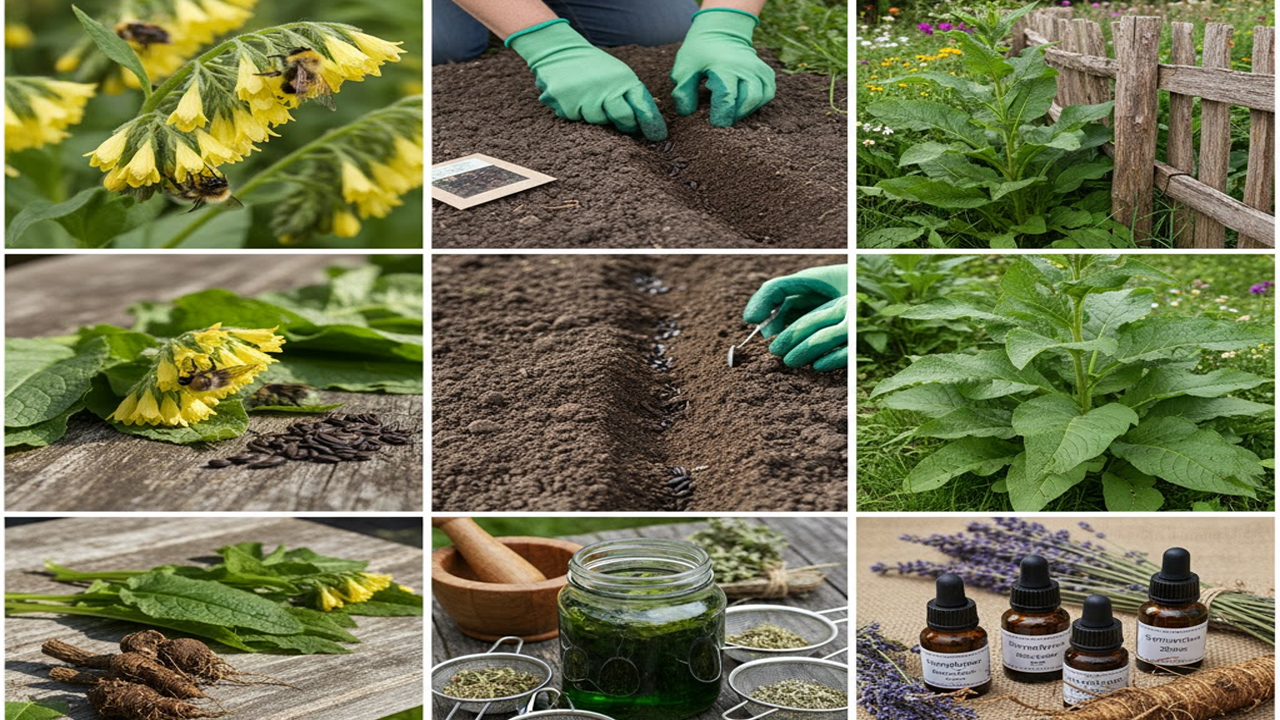Join on WhatsApp
Get the latest updates directly on WhatsApp – motivation, news & more!
Symphytum, commonly known as comfrey, is a remarkable perennial herb cherished for its medicinal, horticultural, and soil-enriching properties. Known botanically as Symphytum officinale, this plant has earned nicknames like comfrey knitbone and common comfrey due to its historical use in healing broken bones and wounds. Whether you’re cultivating comfreys for herbal remedies, soil health, or ornamental appeal, the comfrey plant offers a wealth of benefits.
Comfrey symphytum officinale is native to Europe and parts of Asia, thriving in moist, fertile soils. Its striking comfrey yellow flowers bloom from late spring to early summer, attracting pollinators and adding charm to cottage gardens. Varieties like prickly comfrey and rough comfrey are also popular among gardeners and herbalists.
Choosing the Right Comfrey Seeds and Varieties
When starting your comfrey journey, selecting the right seeds is crucial. Organic comfrey seeds and heirloom comfrey seeds are preferred for their purity and resilience. You’ll find comfrey seeds for sale online or at specialty nurseries, often labeled as comfrey symphytum officinale seeds or common comfrey seeds.
Non spreading comfrey varieties are ideal for controlled gardens, while true comfrey and common comfrey symphytum officinale are excellent for permaculture systems. If you’re looking for medicinal potency, opt for comfrey officinale or knitbone plant strains, which are rich in allantoin and other healing compounds.
Planting Comfrey: Soil, Sun, and Spacing
Comfrey thrives in well-drained, nutrient-rich soil with a pH between 6.0 and 7.0. Choose a sunny or partially shaded location, especially if you’re growing comfrey for its medicinal leaves and roots. Plant comfrey seeds or comfrey root cuttings in early spring or fall, spacing them about 2 feet apart to allow for their expansive growth.
Comfrey plant seeds for sale often come with instructions, but the basics are simple: sow seeds ½ inch deep, keep the soil moist, and expect germination within 2–3 weeks. Once established, comfrey is drought-tolerant and low-maintenance, making it a favorite among organic gardeners.
Caring for Comfrey: Watering, Pruning, and Propagation
Comfrey leaves grow rapidly and can be harvested multiple times a year. Regular watering during dry spells ensures lush foliage, while pruning spent comfrey flowers encourages new growth. Comfrey root systems are deep and vigorous, helping break up compacted soil and draw up nutrients.
Propagation is easy via root division or comfrey root seeds. Simply dig up a mature plant, divide the root crown, and replant. This method is especially useful for expanding your patch or sharing with fellow gardeners interested in comfrey herbal plant cultivation.
Harvesting Comfrey Leaves, Flowers, and Roots
Harvest comfrey leaves when they’re young and vibrant, typically before flowering. These leaves are used in compost teas, mulches, and herbal preparations. Comfrey flower heads can be dried for decorative or medicinal use, while comfrey root is prized for its therapeutic compounds.
In regions like Canada, comfrey root Canada products are popular in herbal markets. Whether you’re making comfrey extract or drying roots for tinctures, ensure ethical harvesting and proper drying techniques to preserve potency.
Medicinal Uses of Symphytum Officinale
Symphytum officinale is a cornerstone of herbal and homeopathic medicine. Known as homeopathic comfrey or knitbone homeopathic remedy, it’s used to support bone healing, reduce inflammation, and soothe bruises. Comfrey medicinal applications include creams, salves, and internal remedies—though internal use should be approached with caution due to pyrrolizidine alkaloids.
Homeopathic medicine symphytum is available in various potencies, including symphytum 30, symphytum 200, symphytum 1m, and symphytum 1000. Popular brands like boiron symphytum officinale and weleda arnica symphytum comp offer symphytum homeopathic remedy blends for joint pain and trauma recovery.
Exploring Homeopathy: Symphytum Q to Symphytum 200C
In homeopathy, symphytum q refers to the mother tincture, used for external applications. Dilutions like symphytum d6, symphytum d12, symphytum 30c, and symphytum officinale 30c are tailored for specific ailments. Advanced potencies such as symphytum c200, symphytum 200c, and symphytum officinale 200c are prescribed for deep tissue healing.
Practitioners may combine symphytum officinale c200 und rhus toxicodendron c30 for joint and bone issues. Other blends include arnica symphytum comp, arnica and symphytum, and silicea baryta carb and symphytum for holistic recovery. Brands like sbl symphytum officinale, infi symphytum n, and dhu symphytum d6 offer trusted formulations.
Comfrey in Modern Herbal Products
Comfrey extract is a key ingredient in topical treatments like a vogel comfrey cream and a vogel symphytum cream. These products soothe sprains, bruises, and muscle aches. Comfrey homeopathic medicine is also available in oral forms, often labeled as homeo medicine symphytum or homeo symphytum.
For bone injuries, remedies like symphytum 200 homeopathic medicine and homeopathy medicine symphytum 200 are commonly recommended. Knitbone homeopathic and homeopathic knitbone preparations continue to be popular among natural health enthusiasts.
Companion Plants and Alternatives to Comfrey
While comfrey is a standout, plants similar to comfrey include rosmarin rosmarinus officinalis and ruta symphytum, which offer complementary healing properties. These herbs can be grown alongside comfrey to create a diverse medicinal garden.
If you’re exploring combinations, arnica cepa symphytum and arnica symphytum weleda are excellent for trauma care. Wala symphytum comp and symphytum comp wala are specialized blends used in European homeopathy. For advanced users, symphytum 15 ch, symphytum 200 ch, and symphytum officinale 9ch offer nuanced healing options.
Final Thoughts on Growing and Using Comfrey
Growing comfrey symphytum is a rewarding endeavor for gardeners, herbalists, and homeopaths alike. From comfrey bone healing to soil enrichment, this plant delivers on multiple fronts. Whether you’re sourcing comfrey root seeds, applying boiron symphytum officinale 30c, or crafting your own comfrey extract, the possibilities are vast.
As interest in natural remedies grows, so does the demand for comfrey homeopathic remedy and comfrey herbal plant products. With proper care, harvesting, and knowledge of symphytum officinale homeopathy, you can harness the full potential of this ancient yet ever-relevant plant.
